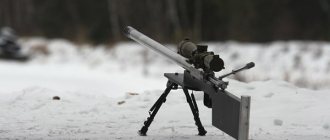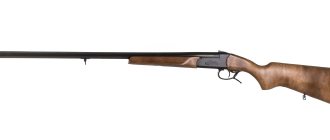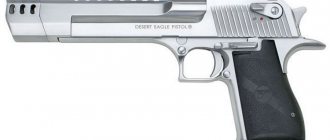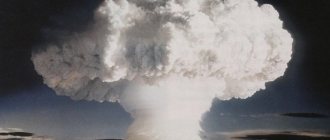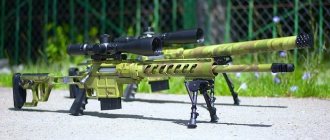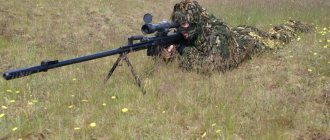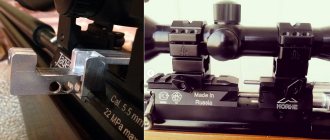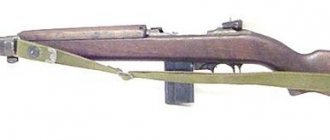About the rifle
Strange sensations arise when you approach this monster. A hefty, impressive and even a little intimidating rifle chambered for .408, simply being in a transport case, already commands respect. At first glance at the impressive rifle stock, the massive muzzle brake, and the bolt cylinder, it becomes clear that the rifle is not just intended for sniper shooting.
For someone uninitiated in the intricacies of sniping, it may seem that the rifle is not intended for long- and ultra-long-distance , but for hunting tyrannosaurs.
Shooting at a distance above three thousand meters is a delicate matter, and therefore the tools for such work should be selected with special care. In addition to the SVLK-14S , which, according to benchrest experts ( benchrest is accuracy shooting, the task of which is to place the entire group of shots at one point), is the best product that money can buy, monstrous-looking sniper ammunition is also used for accurate shooting caliber .408 CheyTac , which at long and ultra-long distances surpasses all currently existing sniper ammunition.
The body of the receiver of the SVLK-14S rifle is made using aircraft-grade aluminum with a threaded insert made of high-alloy corrosion-resistant steel. The shutter is also made of solid, corrosion-resistant steel. The developers of the rifle deliberately left their masterpiece in a single-shot version in order to provide the necessary rigidity of the receiver, which is so necessary for ultra-long-range shooting.
The rifle, which will outshine all world analogues, is a development of one of the very first rifles that came out of the workshop of Vladislav Lobaev - his SVL (Lobaev Sniper Rifle) model 2009 has been setting shooting records for six years at ranges up to and beyond two thousand meters. In the case of the SVLK-14S, , the firing range will be simply incredible - 3400 meters or more. The SVLK-14S had a rather difficult role - to become the best in the world in terms of accuracy and firing range. The crown of the king of ultra-long-range shooting must be lived up to, and this unique rifle, the likes of which, perhaps, in the whole world, will cope with this, according to the convictions of Vladislav Lobaev himself.
Reliable shutter and trigger
Since under standard conditions the sniper does not need to continuously shoot at targets, he may well sacrifice the qualities of the automatic in favor of more accurate fixation of bullets in the chamber.
That is why all modern high-precision units actively use longitudinally sliding butterfly valves. In their design they are more similar to the Mosin-Nagant systems. This weapon was used by soldiers during World War II. For high-quality shooting, the bolt protrusions must be ground and polished to completely eliminate the possibility of leakage of powder gases.
Experts always pay attention to the quality of workmanship and functionality of the striker. The main indicator is the actuation time of the mechanism (the interval between pressing the trigger and the shot itself). This parameter should be small so that the weapon does not have time to naturally deviate from the target. For this purpose, you can additionally use high-quality lubricants.
No less stringent demands are placed on the accuracy of the firing mechanism. For high-quality rifles, all working surfaces are carefully polished so that the trigger is smooth and smooth.
Russian spare parts for the Russian army
Vladislav Lobaev directly states that his specially prepared SVLK-14S will fire with the longest range and the best accuracy among all world analogues. If in the case of the Americans, the “warm-up” for sniper shooting begins at 500 meters, then in the case of the Lobaev rifle, we begin to “warm up” from a distance of 2000 meters. Watching the target through the rangefinder visor, you can observe how the chest area of the rubber growth target is pierced by a group of shots. A very good indicator for “warming up”. Regarding what the Russian record-breaking rifle is made of, Vladislav Lobaev himself says simply:
“We haven’t imported anything for a long time. The rifle is assembled from domestic raw materials. We replaced imported components 100% with our own, domestic production, so this is a completely Russian rifle , there is nothing “from there” in it.”
“We are now working on the production of our own sniper ammunition in .408 caliber. We have already mastered a good bullet, it’s up to the cartridge case. I think we will do this in the near future,” Vladislav .
Regarding what the rifle is aimed at, Vladislav Lobaev says unequivocally:
“To serve the state. My product is, first of all, a sword to protect my country, my Motherland. And the first place where I would like to see the best weapons in the world is in Russia. When special forces units in the army, and in some other structure, are armed with such a rifle, then I will know that my developments are being used successfully. In addition to the SVLK-14S , which we are preparing to set a record, we have projects that will shoot even further. I can’t give all the information yet, but the complex that we are developing will shoot at three and five thousand meters, respectively. These distances are not for sport and not for records, but for the confident work of a sniper within specific dimensions. In conditions where it is not possible to get closer, such a distance will protect the sniper and determine the success of the work.”
Why such a high range?
It is known that during military operations, snipers work in positions no more than 2 km from targets. So why did the Russians make the range 4 km? And all this is due to the fact that Twilight can be used at a closer distance and the closer to the target, the more powerful the shot will be. Some snipers compared US and Russian snipers and admitted that now there are no equals to Twilight in the world, at least in terms of power.
We can say that the Dusk is now the leader among sniper rifles and bears this title honorably and, indeed, well deservedly.
Do you think Western countries will be able to present weapons that will be similar in strength?
A dagger is good for those who have it
Many people who are relatively knowledgeable about sniper weapons do not understand why another complex and amazingly accurate rifle is needed? The answer, no matter how paradoxical it may sound, is because. Because there are no modern foreign, or even mass and small-scale production of rifles that, in combat conditions, would show the same accuracy as the “Lobaevskaya” SVLK-14S . No, and it won't appear anytime soon.
The former army sniper Sergei, who took part in the shooting, was also able to appreciate the merits of the SVLK-14S After half an hour of preparation and several minutes of active shooting, a seasoned and experienced sniper from one of the special forces, who had visited several hot spots, said, getting up from the place equipped for shooting: “This is... A THING!”
It is difficult to deserve stronger praise than the approving words of those who deal with weapons on a regular basis. Vladislav Lobaev himself speaks restrainedly and at the same time optimistically about his rifles:
“Calm and powerful. These are the two words with which I characterize the rifles we produce . To be honest, it’s not easy to produce such weapons, but I see this as my calling, my niche—namely, the production of long-range and high-precision small arms.”
Performance characteristics
| Technical accuracy | 0.3 MOA\9 mm between centers (5 shots at 100m) |
| Maximum Effective Range (sp) | 2500m++ |
| Muzzle velocity | more than 900 m\s |
| Operating temperature range | -45\+65 C |
| Caliber | .408 Cheytac\.338LM\.300WM |
| Length | 1430 mm |
| Height | 175 mm |
| Width | 96 mm |
| Weight | 9 600 g |
| Barrel length | 900 mm |
| Trigger force | reg. 50-1500g |
| Bolt | right |
| Port | right |
| Shop | No |
The characteristics of the special version of the SVLK-14S are almost two to three times greater than the characteristics of all American and European-made rifles. For comparison, you can take the beloved and widely advertised American M200 Intervention rifle. The accuracy of the American product is such that the rifle shows an accuracy of much more than 1MOA (One minute of arc). Lobaev's rifle, under the same conditions, will show an accuracy of 0.2-0.3 MOA, which can be critical for a shot at an ultra-long distance.
TSVL-8 (TSVL-8)
TSVL is an abbreviation of the name “Lobaev Tactical Sniper Rifle” in Latin.
Sniper rifle TSVL-8 (TSVL-8)
Tactical and technical characteristics of the TSVL-8 high-precision sniper rifle
| Length, mm: | 1350 |
| Barrel length, mm: | 680 / 740 |
| Barrel contour, type: | Heavy Gun or Super Heavy Gun (optional) |
| Width, mm: | 62 |
| Height, mm: | 218 |
| Ammunition: | .338 Lapua Magnum cartridge |
| Ammunition: | 5-round detachable box magazine |
| Trigger force, kg: | 0,5-1,5 |
| Maximum effective firing range, m: | 1400 |
| Firing accuracy, MOA (5 shots at 100 meters): | 0.4 MOA (12mm between centers) |
| Initial bullet speed, m/s: | 900 |
| Weight, kg: | 6,5 |
| Operating temperature range, °C: | – 45/+65 |
This model also uses a LOBAEV stainless steel match barrel, and the developer recommends choosing basic contour barrels for this model.
The new bolt group of this model rests on a small aluminum chassis and compound, improving the vibration-damping properties of the weapon.
A new magazine bolt group, COUNT, was developed for this rifle. This is a smaller version of the DUKE bolt group and is also part of the family of bolt groups, the development of which began with the Tsar Cannon.
For reasons of greater portability, this model is equipped with a folding buttstock, adjustable in length and cheek height.
Basic equipment:
• Barrel contour – HG• Barrel length – 680mm• Caliber – 338 Lapua Magnum• Muzzle brake – T-Tuner• Fullers – 8• Bipod – no• PBS – no• HB\TV mount – STD Picatinny• Sight mount – STD Picatinny
Ferrari in the world of rifles
Regarding the shooting record above three thousand meters, which the entire Lobaev Arms team is now preparing to set, it is difficult to say directly. An analogy with Ferrari cars involuntarily arises in your head - powerful, fast, expensive and insanely fast piece products that instill in owners the confidence that at any speed and any maneuver they have a reserve of power. For a long time, the philosophy of the Ferrari company has been the slogan: “Do the best, or not do it at all.” The SVLK-14S rifle is the Ferrari of the world of high-precision sniper systems. It is not a mass-produced product, but it gives the shooter a performance that no other rifle in the world can provide.
SVLK is a kind of standard of reliability, a guarantor of the fulfillment of the task assigned to the rifle. The upcoming record for shooting at a distance of more than three kilometers, which the Lobaev Arms team is going to set with the help of this rifle, opens up new horizons for sniping and its use in combat, which will no doubt be appreciated in the high offices of the Russian Ministry of Defense. Delight, joy, pride, strength, confidence are the only feelings that are felt when firing from the SVLK-14S is completed and the target is hit.
Source
Production history
In September 2010, the team moved to fulfill the contract to launch a plant in the UAE. The reason for the move is said to be a conflict of interests with IzhMash, but there is no confirmed information. Since 2011, Vladislav Lobaev has successfully produced his rifles in the UAE; they have already been adopted by the UAE Army.
In mid-2013, Vladislav Lobaev returned to Russia and founded the LOBAEV corporation, which includes the enterprises Lobaev Hummer Barrels and Lobaev Arms, LLC Design Bureau of Integrated Systems. Currently, the SVL model range includes 7 main models, and new models are also being developed.
SVL are produced in the city of Tarusa by a private company (owner - V. E. Lobaev) using equipment imported from the USA.
↑ Record for 3400: how it happened
There was precipitation all week and the wind was blowing, at times reaching gale force. On April 9, 2015, the weather forecast promised a single sunny day, on which it was decided to go out with a possible attempt to set a new world record for firing range.
The Lifenews film crew, designed to record this event, arrived in an expanded format. The guys were very serious: they armed themselves with 6 cameras and a quadcopter, and the whole thing was managed by the chief director of the channel.
Everything was ready for the arrival of the guests. Let me remind you: the weapon used to set the record was a custom version of the SVLK-14 C - a design of the model that differs from the base one: stock, titanium tire, titanium striker, custom coating and a short barrel 780 mm long. This barrel, in combination with our new D30 bullet, gave almost the same speed as the basic SVLK-14S with a long barrel.
The scope used was a proven one - IOR Valdada 5.8-40x with an adjustment rate of 100 MOA. Its high magnification is convenient for precise aiming at long ranges, and the correction is sufficient for shooting up to 2300m, but this, however, is only on SVLK-14 rifles. Any other rifle in the world in this caliber will require a scope with a large adjustment rate.
Improvements after the first test shooting concerned an increase in the height and inclination of the bar. The previous version did not provide sufficient tilt for shooting at 3400m. The last two hundred meters “eat up” almost 100 MOA of correction and we were only about 30 minutes short. Also, the height of the first bar turned out to be insufficient - the sight snatched the edge of the muzzle brake, which gave the picture a characteristic haze, although it did not block aiming.
When choosing between making a new rail and using the existing 400 MOA adjustable rail, we decided on a rigid milled rail to ensure that additional factors such as possible movement of the adjustable rail, which had not yet been tested, were eliminated.
The rail was immediately made with a reserve of 260 MOA, in order to be able, if necessary, to shoot further away.
The high bar entailed moving the butt plate to a new height, which required the manufacture of a special adapter. This simple measure made the butt and the shooting itself as comfortable as possible.
For record shooting, we decided to try our new D30 bullets. With a mass similar to the American J40, they differ in geometry and have higher manufacturing accuracy, which has a positive effect on the accuracy of fire. The slightly larger fullness of the bullets (the diameter of the leading part) in combination with a channel adapted for it made it possible to obtain a speed of more than 900 m/s on a short barrel without exceeding the pressure, which brought the rifle in this “short” version closer to the performance of the basic long 900 mm barrel on a standard SVLK-14.
The shooting plan was as follows: check the angle of the bar; “reset” the system; if there is time left, shoot the record.
The event and preparation took the entire daylight hours. At noon we left for the place. Installing cameras at the target, filming the entrance and panoramic views using a quadcopter took several hours.
In order not to waste time, we whiled away it by calculating the corrections. This is where the fun started. Judging by the calculator, we should have set it to 22 MOA only for derivation. The wind, which often reversed direction, was 25 MOA. Thus, an obvious tactic for working with the wind emerged. In order not to add up the correction and not to make a mind-boggling almost 50 minutes of horizontal correction, the “red” condition was chosen, to compensate for which a ridiculous 3 MOA was required. She was shot. “Green” just came less often, replacing a short 12-hour oncoming condition. The wind on the ordinate was read by us as 3 m/s, which was fully confirmed by the shooting.
It must be said that all calculated data were 100% (!) fully confirmed by shooting, with an accuracy of half a minute. It was unexpected. In fact, due to infrequent shooting practice, I developed a childhood disease - distrust of the calculator. So much so that I didn’t even add the required 3 MOA to the flywheel, thinking that I hadn’t taken something into account anyway. I also did not add an additional half-minute of vertical space, as required by the smart calculator.
This led to the fact that when we started shooting we were undershot and 10 meters to the left. This was not immediately detected by the target team, since it was in cover, and even on the side of the target, and could more or less see hits almost within a radius of 10 meters from the target.
Also, due to the terrain, we did not have the opportunity to observe the misses ourselves, although the weather and a moderate mirage would have allowed this to be done even with a 40x scope, and we shot almost “blindly”, relying on very approximate information about the misses, such as: “ undershoot", "somewhere nearby" and so on. Thus, there was no need to rely on the target team to adjust the fire.
Having made a slight move up and to the right, we immediately became attached. The bullet passed 70-80 cm to the left of the edge of the shield, falling 4 meters behind the target. The next three shots were placed in front of the target at a distance of 20, 10 and 1 meter, respectively. The poles, dug into the ground after shooting, showed that they were all on target, that is, the work of reading the wind was done by my “second” number not just “excellent,” but “indecently excellent.” The vertical in the form of hits in front of the target reflected the real picture of finding the correct upward takeoff.
We realized that we were very close to hitting the target and on the next, 5th shot, that’s what happened - it flew into the lower part of the target at 6 o’clock. It was made with an offset that accurately reflected the initial calculation data from the calculator, which I was too lazy to enter into the scope.
After mutual congratulations, we went to inspect the target and it was more difficult than record shooting. Spring swampiness and the wet mess of collective farm fields made the path to the target impassable for cars. There was only one motorcycle, but we had to carry cameras and a rifle for selfies and quietly hope that everything was in order with the camera at the target at the moment of impact. The whole process of traveling back and forth, along with filming on location, took several hours.
But it is during such a journey, to the target and back, that it begins to dawn on you what it really is - a range of 3400 meters.
Production
In the small Russian town of Tarusa on the banks of the Oka, two hours drive from Moscow, in a small one-story building there is an amazing. Even if she had put into production the production of those very Tsar Cannons, it would not have become more amazing. The Tsar Cannon is known among precision shooting professionals for its rifles. The most accurate in Europe. No more, no less.
“If my rifle shoots in a competition, then the rest fight for second place
,” says Lobaev
Among people who can easily hit, let’s say, a soccer ball from a distance of a kilometer, Vladislav Lobaev is a famous person. An almost permanent judge of most long-distance shooting competitions, the participants of which are prohibited from being photographed, he himself at first gives the impression of being a person “from the structures”. Although, as they say, he was “not a member” of either the army or other law enforcement agencies. Nevertheless, he talks sparingly about his past: he became interested in long-distance shooting - benchrest, and when he started shooting at the world championships, he ran into problems with equipment. He went to America, completed an internship with Speedy Gonzalez and Clay Spencer, returned to Russia, founded, received a license from the Federal Agency for Industry to produce rifled weapons, bought several million dollars worth of high-precision equipment in America and now makes the best rifles in Europe. It's simple. I would just like to note that not every hobby leads to the world championships in precision shooting. It is no easier to learn how to make rifles from Speedy Gonzalez (this is not a cartoon racer and the hero of a popular song) or from Clay Spencer than it is to learn machine guns from, say, Mikhail Kalashnikov. No one except Vladislav managed to obtain a private license in Russia, nor, indeed, did they manage to privately import a weapons factory into the country, albeit a small one. Well, when asked where he could talk to the owners of his rifles, Lobaev immediately sent him to the Presidential Security Service. And, what’s even more incredible, when the Service heard Lobaev’s name, they did not refuse to comment. In general, the biography of Vladislav raises more questions than the biography of, say, Stirlitz. But the article is not about him, but about his rifles. He can talk about them for hours.
Working with material
Theoretically, there are only two models of Tsar Cannon rifles - OVL (Lobaev's hunting/experimental rifle) and SVL (Lobaev's sniper/special rifle). Practically - an uncountable number, since Lobaev makes rifles to order. Everything can be discussed: barrel length, caliber, bolt group, stock, rifling pitch, compensator, muzzle brake, etc. You can simply bring a bullet, and they will make you a rifle specifically for this bullet. Vladislav himself has not deciphered abbreviations for a long time. It’s just that if “OVL” is written on the barrel, it means the customer is a private person. If “SVL” means special structures.
“The Tsar Cannon” only works with stainless steels, or more precisely with grades 416R and 416T, if that tells you anything. Other stainless steels are not actually used for the production of barrels. “We work only with stainless steels, and not because we can’t work with any other,” says Lobaev. — It’s just that stainless steel has the necessary corrosion and wear resistance. From the point of view of service life and preservation of performance characteristics, it is an ideal material today.” What are the difficulties of working with stainless steel? This is a high alloy steel, it is harder than traditional barrel steels and requires more wear-resistant tools.
The steel is usually American or German. In principle, it would be possible to use domestic steel - Zlatoust, for example, undertook to brew such, but in very large volumes, which the Tsar Cannon was simply unable to master. It is more profitable to import.
By the way, if you see a Russian stainless steel barrel, then it can only be the Tsar Cannon - no other company makes barrels from this metal. And in all of Europe there are only two more companies: the German Lothar Walther and the Scottish Border Barrels. All other European barrel manufacturers make maximum barrels from medium-alloy chromium-molybdenum steel.
Blanks
The steel comes in the form of six-meter rods, which are cut into the required pieces. Initially, the workpieces are quite uneven, so they are ordered with an allowance for grooving and turned on a lathe to an ideal cylinder of the required diameter. The maximum length of barrels that the Tsar Cannon can drill on its equipment is 95 cm. All production equipment is American, which can be explained simply: in the USA there are several hundred (!) manufacturers of high-precision barrels and rifles, and this industry is developed like nowhere else in the world world. In addition, Vladislav learned the art of making such rifles in America.
After the blanks are turned to the required diameter, they are inserted into a dual-spindle drilling machine, which can process a pair of barrels at the same time. A special tool is used - deep drills. The Tsar Cannon has almost the entire range of calibers: .22, .25, .270, .234 (6 mm), 7 mm, 6.5 mm, .30 (7.62 mm), .338 (8, 6 mm) and .408 (10.3 mm). The 408 caliber is Lobaev’s pride. “We are the only ones in Europe who do it. This is not to go after elephants, but for shooting at 2-3 km,” adds Vladislav.
The main problem in this operation is the tool moving away from the drilling axis. They fight it by choosing the correct processing mode (feed rate and revolutions) and - most importantly - by correct sharpening of the drill. This is generally a key operation - if the sharpener gets sick, production can stop.
One drill without re-sharpening, depending on the steel grade, can withstand from 10 to 50 barrels. A set of a pair of drills costs $1500-2000, and with proper care they last almost forever. Since Soviet times, there have been stories that the best trunks are the first from a batch drilled with one drill. This is nonsense, explains Vladislav Lobaev, since drilling, although important, is a preliminary and not a finishing treatment of the barrel bore.
After drilling, the barrel is marked. For example, 338 is the caliber, then 323 is the diameter of the drill, 330 is the diameter of the reamer, 3415 is the mandrel, 12 is the pitch and 75 is the technological batch number, by which the company can track the fate of a particular barrel. For example, if a certain barrel shoots record-breakingly well and reacts minimally to the wind, using the markings you can restore the technology and make a “twin”. From one batch (1.5-2 tons) of steel, 240-320 barrels are produced.
Additional drilling
Reaming - the next, one of the most critical operations - forms the final diameter of the trunk along the fields. It is produced on a precision lathe with a tool called a reamer. We can say that this is precision drilling of the barrel. When reaming, the alignment of the barrel is not so critical, since the tool goes along an already drilled channel. By the way, unlike drills, the reamers on the Tsar Cannon are made by themselves, which gives a wide scope for maneuver.
But that's not all. The next operation is honing. An abrasive hone is made under each barrel, which is pulled through the channel, performing rough polishing.
Should you chop it?
The process of applying rifling is called burnishing. The machine is a horizontal press with a copier, which sets the pitch of the rifling. To put it simply, the machine, rotating smoothly, pulls a carbide mandrel of very high hardness (70-80 units on the Rockwell hardness scale; barrel steel, for example, has a hardness of 32-34 units) with protruding rifling through the bore. This is a one-time operation that produces rifling using pressure in literally ten seconds. Before pulling the mandrel, a special lubricating fluid is applied to the internal bore of the barrel to reduce friction, the composition of which is a professional secret of each barrel manufacturer and is kept secret.
A separate mandrel is required for each caliber and pitch (plus or minus an inch). For example, for 30 gauge there is a mandrel with a pitch of 12 inches. This means that the machine can make cuts in increments of 11 to 13 inches.
Dorn is the most expensive item among all gunsmith's tools and, depending on the caliber, costs from $1000 to 3000. Dorn is a long-liver. If you care for it properly (and after each pass the mandrel is re-polished to remove possible micro-burrs), then it can last for several thousand barrels.
The advantage of this rifling technology is that it creates surface hardening of the barrel bore, which in turn has a beneficial effect on the service life and resistance to temperature influences. The downside is the inevitability of internal tensions that have to be relieved. If you don’t know how to relieve stress, then the formation of rifling using the burnishing method is a road to nowhere, says Lobaev. This is know-how. In words, everything is very simple - heating to a certain temperature, and then cooling. Temperature conditions are selected individually for different steel grades. If we let go too much, we will lose survivability and the barrel will become more flexible. If you keep it very hard, you may not release the tension, and the barrel will bend after several shots under the influence of temperatures, reminiscent of barrels made using rotary forging technology.
Cutting in the Tsar Cannon is the fastest process - only ten seconds. Drilling, for example, takes an hour or twenty hours, and deployment takes about thirty minutes.
Into the furnace!
After cutting, the almost finished barrels are mounted vertically and sent to a vacuum oven. The principle of tempering is simple - first, the barrels are smoothly heated to a certain temperature, maintained at it, and then cooled smoothly, and all this happens in a vacuum. If you do the same thing in air, it will no longer be tempering, but hardening of the metal. And Lobaev, let us remind you, makes not checkers, but rifles.
Graters
The next operation is grinding the barrel. For it, a lead lap is smelted in the shape of a corresponding mandrel, a special abrasive composition is applied to it, which the craftsmen prepare themselves, and each barrel is polished by hand. All. This is the most final, finishing polish. The operation, by the way, is extremely critical for the quality of the barrel, allowing you to obtain different geometries - for example, barrel cones or bells. Why cones and bells are needed is a topic for the next article.
Bolt groups
The two main components in precision shooting are the bullet and the barrel. Everything else in the rifle should not degrade its qualities, says Lobaev. For example, a shutter. “My shutter doesn’t make things worse. This is my pride - our new development, our own bolt group. In particular, it is now found on rifles adopted by one of the domestic security forces. Although we do everything - we have a full production cycle. We can custom make any bolt group in the world by simply repeating it.” The new bolt group was designed to accept .408 and .338 caliber cartridges and other smaller caliber magnums.
Speedy Gonzalez
Wikipedia knows only one Speedy Gonzalez - a Warner Brothers cartoon character. In the shooting world, Speedy Gonzalez is primarily a legendary American gunsmith, known for his high-precision barrels and especially stocks. How Lobaev managed to get his blessing, only he himself knows, but the “Tsar Cannon” installs its barrels in stocks designed by Speedy Gonzalez himself. There are simply no better recommendations in the world. Although the Tsar Cannon makes them itself.
“We used to make stocks from three materials: fiberglass, carbon fiber and Kevlar carbon,” Vladislav shows a huge collection of multi-colored stocks on the wall of the workshop, “but now we have settled only on carbon fiber and Kevlar carbon. In the world, besides us, only one other company from the USA makes a benchrest stock made of carbon fiber, and Kevlar carbon, which is even stronger, is made only by us; no one wants to mess with it: it cuts and mills poorly.” Lobaev has something to be proud of - the European Championship was won on his boxes.
Tarusa
Rifles from Lobaev are not a cheap pleasure, although there is no alternative. “If our rifle shoots in a competition, then everyone else is fighting for second place,” Vladislav categorically snaps. “Since we started working, not a single major competition in either sniping or benchrest in Russia has been won with a rifle other than ours.” Indeed, if we take 2008, in the European Benchrest Championship, two gold medals in the overall standings and in the “heavy varmint” class were won by Novosibirsk resident Igor Zhukov using a Lobaev rifle.
Prices for OVL in medium calibers 6.5 mm - .308 start from 350,000 rubles, and the most expensive and long-range in 408 caliber will cost no less than 520,000 rubles. However, even if you have that kind of money and desire, you should not rush to Tarusa - until the end of the year, Lobaev’s company does not accept orders from individuals, since it is overwhelmed with orders from special forces. Whatever one may say, ultra-long-range shooting is a purely applied sport, intended for testing technologies that are later used by military and police structures. In the USA it’s the same - benchrest legends mainly make weapons not for competitions, but for law enforcement agencies.
The day is coming to an end, it's time to get ready to head back to Moscow. Vladislav and I are standing on the porch of his small factory near Tarusa. The weather is clear, the provincial setting is somehow relaxing and peaceful. “Why Tarusa? - Lobaev asks again. “It’s just that I have a dacha here.” And slyly squints at the sun.
Sniper Hunter
The story has an equally incredible continuation. Before leaving, I asked Vladislav to give me the phone number of some authoritative shooter who shoots from Lobaev’s rifle. Vladislav gave the phone number of a person from the Presidential Security Service. I have worked in journalism for more than ten years and can authoritatively say that getting a comment from such a specialist is much more difficult than, for example, Putin or Medvedev. Nevertheless, a few days later I was sitting at one of the special forces bases in a cozy office, on a leather sofa lay a pair of well-worn Lobaev rifles, and a pleasant middle-aged man, who asked to be identified simply as a “sniper of the presidential security service,” told me about Lobaev’s relationship with this very service.
Quality barrel
A reliable and high-quality rifle is an essential tool for every sniper. To ensure that the purchased weapon does not fail at the most crucial moments, you need to pay attention to the quality of the barrel and its thickness.
Most often this parameter is within ¾ inches. A thick barrel is much less susceptible to thermal deformation, as it copes with high temperatures more effectively. In some cases, specialists mill small longitudinal grooves on the barrel of a rifle for better heat dissipation. The smelted metal must have high strength properties and excellent ductility.
When making a barrel, a future channel is first drilled into the blank rod, which is then processed using a reamer. The next stage is the creation of universal rifling. There are different technologies for this. Large gun manufacturers often use the cold forging method.
Manufacturers place a frame made of heavy-duty alloy into a special barrel bore. This blank will be used as a matrix. Incisions of the future trunk must be made on the frame. Only after this, special hammers gradually tap the workpiece under high pressure.
Thanks to this, the matrices are evenly pressed into the metal, leaving peculiar imprints in the form of cuts. After all these manipulations, the barrel is removed from the mandrel.
The universal cold forging technology requires the use of expensive equipment, but ultimately provides the highest precision in applying all planned cuts. According to another production program, blanks are extruded into the barrel bore with a special tool - a mandrel. There are technologies for cutting a barrel using a cutter and electrochemical processes.


